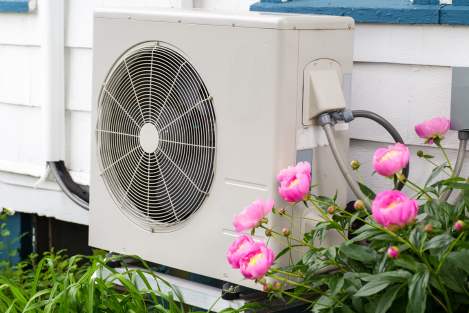
Written by Kayla Jane Barrie Updated on Feb 21, 2025 6 mins read

A heat pump system is worth considering if you're looking for ways to heat and cool your home while reducing energy bills.
Heat pumps are a reliable and well-established technology in Canada that can provide year-round comfort control for your home. They can supply heating during the winter and cooling during the summer and sometimes heat hot water for your home.
Based on the Households and the Environment Survey conducted by Statistics Canada, the proportion of heat pumps installed as the primary heating system in Canadian homes has doubled from three to six percent between 2013 and 2021. Additionally, Statistics Canada has reported that by 2023, seven percent of all Canadian households use a heat pump.
This blog post will explore heat pumps, how they work, insurance considerations, and associated costs.
Heat pumps are highly efficient heating and cooling systems that transfer heat between indoor and outdoor environments. Unlike conventional heating systems, such as your furnace or fireplace, that generate heat, heat pumps move existing heat from one location to another. They operate on the principle that heat naturally flows from warmer to cooler spaces.
A heat pump is fully reversible, meaning that it can both heat and cool your home, providing year-round comfort.
Heat pumps heat or cool homes by extracting or adding thermal energy. When energy is extracted from a source, the source's temperature decreases. In cooling mode, a heat pump removes thermal energy from the home, cooling the space. This principle is like what air conditioners and refrigerators use.
There are two primary categories of heat pumps: air-source and ground-source, also known as geothermal. Air-source heat pumps take heat from the outdoor air, while ground-source heat pumps extract heat from the ground. Both types of heat pumps use refrigerant to aid in transferring heat.
Heat naturally moves from warmer to cooler areas, like when heat from inside a building escapes to the colder outside in winter. A heat pump uses electricity to reverse this process and move heat from a colder area to a warmer one. This way, it pumps energy from a place where it's not useful to one where it's needed.
When installing a heat pump, it's important to consider insurance. Certain home insurance providers may offer discounts or other benefits for homeowners with energy-efficient systems, like heat pumps.
Homeowners should also inform their insurance providers about any changes to their HVAC systems to ensure coverage in unexpected incidents.
This CBC article from November 2023 shares some insights into the importance of letting your insurer know if you are installing a heat pump so there are no surprises down the road. Some heat pumps may only regulate temperatures in a portion of a home, depending on their size and placement, which may require an additional heat source. This requires you to inform your provider about any wood stoves or other heating elements.
The cost of installing a heat pump varies depending on factors such as the type of heat pump, the complexity of installation, and regional labour costs. In Ontario, installing or replacing a heat pump can range from $6,700 to $12,000.
Here is a list* of cost considerations, depending on the type of heat pump you install compared to gas furnaces and central air:
Consider the long-term benefits, including reduced energy bills and potential government incentives for adopting energy-efficient technologies.
*Source: CBC heat pump savings
Heat pumps come in various sizes and types. Choosing the right one depends on your home’s layout, square footage, climate, and power source. If you are looking to install a heat pump, here are some aspects to consider:
Taking the time to assess these factors carefully will help you make an informed decision and select a heat pump that best meets your home's heating and cooling requirements.
Heat pumps come in various types and sizes, and choosing the right one depends on factors such as your home's layout, square footage, climate, and the possibility of accommodating a ducted system.
Air-source heat pumps utilize outdoor air as an energy source for heating and releasing energy into the air when cooling your home. Air-to-air heat pumps, whether ducted or ductless, are the most prevalent in Canada.
Ducted air-source heat pumps have the indoor coil in your home's ducts, while ductless counterparts have the indoor coil in a floor or wall unit. Among air-air heat pumps, which primarily regulate the air inside your home, most installations in Canada fall into two categories:
Air-water heat pumps are a type of heating and cooling system suitable for homes that use hydronic distribution systems, such as low-temperature radiators, radiant floors, or fan coil units. These systems transfer thermal energy to the hydronic system in heating mode and extract thermal energy from the hydronic system in cooling mode, releasing it to the outdoor air. These types of heat pumps are rare in Canada.
You can get home insurance in Ontario if you have a heat pump; just make sure you are clear with your broker if it is a secondary source of heating or not. This may impact how much you pay.
You might be covered depending on the cause of damage to your heat pump. You can check your documents to confirm outline policy limits and causes where you would have coverage. Normal wear and tear is usually not covered, but damage from a flood, extreme weather, or vandalism could be.
Most insurers and specialists recommend having a backup heat source with your heat pump. Depending on your climate, you may need more than a heat pump to heat your home. If you have a ducted heat pump, it may provide a stronger solution as your primary heat source.
Heat pumps are revolutionizing how Canadians approach indoor climate control. With their energy-efficient characteristics and potential for cost savings, more homeowners recognize the benefits, and the adoption of heat pumps is expected to rise, contributing to both energy savings.
| Categories | Home |
|---|---|
| Tags | Protect Your HomeSeasonal HomeHome Maintenance |
Read our insurance blog to get helpful tips, information and news.
Has your car been totalled in an accident? Is your car a write off? Learn about vehicle write offs for a total loss insurance claim.
Get the facts on Toronto's auto theft problem. We break down the data, reveal the most-stolen vehicles (including the Honda CR-V and Lexus RX 350), and show which neighbourhoods are most affected.
Dive into the world of auto theft with our blog on the most stolen cars in Canada. See the most stolen cars across Canada, including provincial lists for Ontario and Quebec, and learn how high-risk models can affect your car insurance premiums.
Drive safe this winter! Check out these tips for driving in snowy and icy conditions in Ontario. Get other helpful info and FAQs on winter driving.